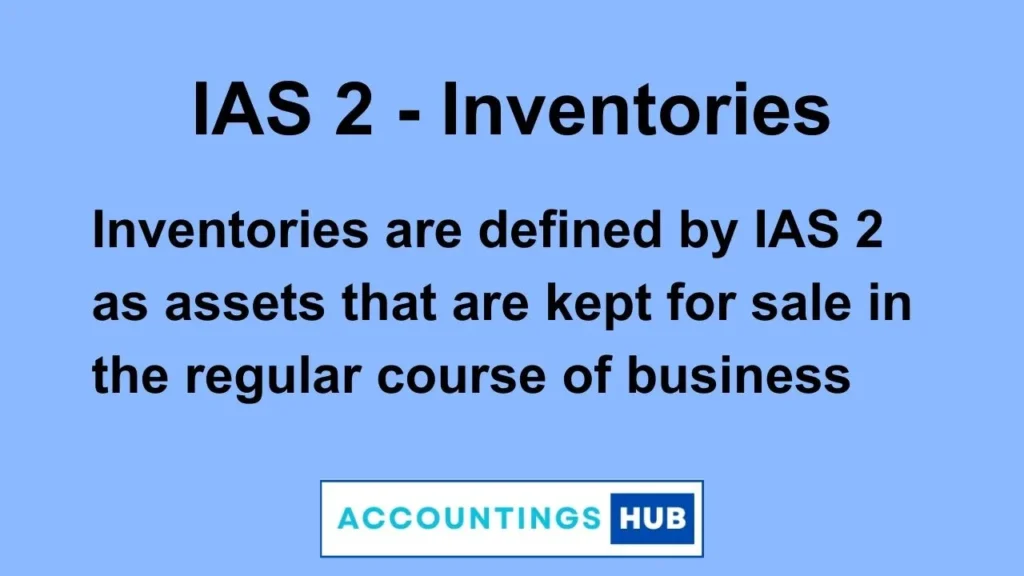Inventories are defined by IAS 2 as assets that are kept for sale in the regular course of business, in production for such a sale, or as supplies or materials to be used in the creation of goods or provision of services.

Inventories are assets:
- a) held for sale in the ordinary course of business (finished goods);
- b) in the process of production for such sale (work in process); or
- c) in the form of materials or supplies to be consumed in the production process or the rendering of services (raw materials and other supplies).
Goods in Transit
Goods in transit are also categorized as inventory of the buyer entity, where control (risk and rewards) is transferred to the buyer.
The basic requirement for counting an item in inventory is economic control rather than physical possession (substance over form). Therefore, when an entity purchases inventory, the item is included in the inventory even if the purchaser does not have physical possession of those items.
Measurement
We always measure inventories at lower of cost and net realizable value (NRV).
Costs of Inventories
The costs of inventories shall comprise the following:
- a) all costs of purchase,
- b) costs of conversion,
- c) other costs incurred in bringing the inventories into their present location and condition e.g. it may be appropriate to include non-production overheads or the costs of designing products for specific customers.
Costs of Purchase
| The following table summarizes the measurement of costs of purchase. Include | Exclude |
| · Purchase price · Non-refundable import duties · Non-adjustable taxes · Transport and handling costs · Other costs directly attributable to the acquisition | · Refundable sales tax · Adjustable income tax · Costs not directly attributable to the acquisition · Discounts and rebates |
Costs of Conversion
These include:
- a) costs directly related to the units of production, such as direct labor
- b) a systematic allocation of fixed and variable production overheads incurred in converting materials into finished goods.
Fixed production overheads
Fixed production overheads are those indirect costs of production that remain relatively constant regardless of the volume of production, such as depreciation and maintenance of factory buildings and equipment, and the cost of factory management and administration.
Variable production overheads
Variable production overheads are those indirect costs of production that vary directly, or nearly directly, with the volume of production, such as indirect materials and indirect labor.
Costs to be excluded
Examples of costs excluded from the cost of inventories and recognized as expenses in the period in which they are incurred are:
- abnormal losses and wastages;
- storage costs, unless necessary for the production process;
- administrative overheads; and
- selling costs.
Storage costs of raw materials requiring further processing may be included in the cost of inventory. However, the storage cost of finished goods is not included in the inventory cost as it does not contribute to bringing the inventory to its present location and condition.
Level of Production
| The conversion costs are included in inventory based on the following levels of production: Cost | Level of activity |
| Direct labor and other direct costs | Actual level of production |
| Variable production overheads | Actual level of production |
| Fixed production overhead | The normal production capacity (actual production is used, if it exceeds normal capacity). |
Normal capacity
Normal capacity is the production expected to be achieved on average over several periods or seasons under normal circumstances, taking into account the loss of capacity resulting from planned maintenance.
Frequently Asked Questions
What is the IAS 2?
Inventories are defined by IAS 2 as assets that are kept for sale in the regular course of business, in production for such a sale, or as supplies or materials to be used in the creation of goods or provision of services.
What is the objective of IAS 2?
The purpose of this Standard is to specify the accounting treatment for inventories. The amount of cost that should be recorded as an asset and carried forward until the related profits are recognized is a major problem in inventory accounting.
What is IAS 2 classification of inventory?
Inventories are classified in the form of merchandise, production supplies, materials, work in progress, and finished goods.
What is an example of IAS 2?
Examples include factory management and administrative expenses, as well as the depreciation and upkeep of structures and machinery utilized in the production process. Based on the typical capacity of manufacturing facilities, these overheads are assigned to each production unit.
